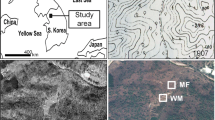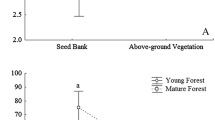Abstract
A survey was carried out to determine the density and species composition of germinable seed in the surface soil layers of 30 plots within a coniferized lowland woodland in East Kent in order to establish the resources available for habitat creation in the event of some areas being modified during a proposed holiday village development. The selected plots included conifer plantations (up to 69 years old), broad-leaved plantations and the semi-natural broad-leaved edges that remain on parts of the perimeter of the site which were used as the control. A total of 13 682 seedlings emerged from the soil samples during the four-month germination trials. Fifty-two species were identified of which eight were ancient woodland indicator species for south-east England. The most abundant species represented in the seed banks were: Juncus effusus, Rubus fruticosus, Carex sylvatica, Betula pendula and Agrostis tenuis. Between-site comparisons of coniferous plots of different ages revealed a marked reduction in the seed species and seed density in plantations over 65 years old. Results of soil nutrient and texture analyses ruled out the likelihood of edaphic factors being responsible for between-site differences in seed bank composition. Seed species richness and diversity (Shannon-Wiener diversity index) were greatest in the semi-natural broad-leaved edges, but the diversity index used also showed that two replanted conifer sites had high values despite few species being present. The usefulness and limitations of diversity indices in the context of seed bank studies is discussed. From the results of the study, management proposals for the site have been put forward in order to maintain floristic diversity and mitigate the impact of the proposed development.
Similar content being viewed by others
References
Beatty, S.W. (1991) Colonisation dynamics in a mosaic landscape: the buried seed pool. J. Biogeog. 18, 553–63.
Bigwood, D.B. and Inouye, D.W. (1988) Spatial pattern analysis of seed banks: an improved method and optimised sampling. Ecology 69(2), 497–507.
Brown, A.H.F. and Oosterhuis, L. (1981) The role of buried seed in coppicewoods. Biol. Cons. 21, 19–38.
Chancellor, R.J. (1959) Identification of Seedlings of Common Weeds (Bulletin No. 179). London: Her Majesty's Stationary Office.
Chancellor, R.J. (1966) The Identification of Weed Seedlings from Farm and Garden. London: Blackwell Scientific.
Clapham, A.R., Tutin, T.G. and Warburg, E.F. (1962) Flora of the British Isles, 2nd Edition. London: Cambridge University Press.
Dutoit, T. and Alard, D. (1995) Permanent seed banks in chalk grassland under various management regimes: their role in the restoration of species-rich plant communities. Biodivers. Conserv. 4, 939–50.
Granstrom, A. (1987) Seed viability of fourteen species during five years of storage in a forest soil. J. Ecol. 75, 321–31.
Granstrom, A. (1988) Seed banks at six open and afforested heathland sites in southern Sweden. J. Appl. Ecol. 23, 297–306.
Grime, J.P., Hodgeson, J.G. and Hunt, R. (1990) The Abridged Comparative Plant Ecology. London: Unwin Hyman.
Harris, M.J. and Kent, M. (1987) Ecological benefits of the Bradford-Hutt system of commercial forestry II. The seed bank and the ground flora species phenology. Quart. J. For. 81, 213–24.
Hill, M.O. and Stevens, P.A. (1981) The density of viable seed in soils of forest plantations in upland Britain. J. Ecol. 69, 693–709.
Jasper, D.A., Abbott, L.K. and Robson, A.D. (1991) The effect of soil disturbance on vesicular-arbuscular mycorrhizal fungi in soils from different vegetation sites. New Phytol. 118, 471–6.
Lowday, J.E. and Marrs, R.H. (1992a) Control of bracken and the restoration of heathland I. Control of bracken. J. Appl. Ecol. 29, 195–203.
Lowday, J.E. and Marrs, R.H. (1992b) Control of bracken and the restoration of healthland. III. Bracken litter disturbance and heathland restoration. J. Appl. Ecol. 29, 212–17.
Marren, P. (1990) Woodland Heritage-Britain's Ancient Woodlands p. 89–93. Newton Abbott: David and Charles.
Marrs, R.H. and Lowday, J.E. (1992) Control of bracken and the restoration of heathland. II. Regeneration of the heathland community. J. Appl. Ecol. 29, 204–11.
Merryweather, J. and Fitter, A. (1995a) Phosphorus and carbon budgets: mycorrhizal contribution in Hyacinthoides non-scripta under natural conditions. New Phytol. 129, 619–27.
Merryweather, J. and Fitter, A. (1995b) Arbuscular mycorrhiza and phosphorus as controlling factors in the life history of Hyacinthoides non-scripta. New Phytol. 129, 629–36.
Phillips, R. (1978) Wild Flowers of Britain. London: Pan Books Ltd.
Phillips, R. (1986) Woodland Wild Flowers. London: Elm Tree Books/Hamish Hamilton Ltd.
Phillips, R. (1994) Grasses, Ferns, Mosses and Lichens of Great Britain and Ireland. London: Macmillan.
Philp, E.R. (1982) Atlas of the Kent Flora. The Kent Field Club.
SGS Environment (1994) Environmental Statement: proposed ‘Oasis’ holiday village, West Wood, Lyminge Forest, Kent.
Simmons, E.A. (1992) The ground flora of conifer-broadleaf plantations. PhD thesis, Wye College, University of London.
Stieperaere, H. and Timmerman, C. (1983) Viable seeds in the soils of some parcels of reclaimed and unreclaimed heath in the Flemish district (Northern Belgium). Bull. Soc. Royal. Bot. Belg. 116, 62–3.
Thompson, K. and Grime, J.P. (1979) Seasonal variation in the seed banks of herbaceous species in ten contrasting habitats. J. Ecol. 67, 893–921.
Thompson, K. (1993) Seed Buoyancy in Air, Germination at Alternating Temperatures, Persistence in Soil. In Methods in Comparative Plant Ecology (G.A.F. Hendry and J.P. Grime, eds). London: Chapman & Hall.
Warr, S.J., Kent, M. and Thompson, K. (1994) Seed bank composition and variability in five woodlands in south-west England. J. Biogeog. 21, 151–68.
Author information
Authors and Affiliations
Rights and permissions
About this article
Cite this article
DOUGALL, T.A.G., DODD, J.C. A study of species richness and diversity in seed banks and its use for the environmental mitigation of a proposed holiday village development in a coniferized woodland in south east England. Biodiversity and Conservation 6, 1413–1428 (1997). https://doi.org/10.1023/A:1018345915418
Issue Date:
DOI: https://doi.org/10.1023/A:1018345915418




